There are many reasons your guitar may need a guitar set-up and over my years as a Luthier, I have seen a multitude of issues with both old and new guitars that have not been maintained or set up correctly.
High action, stiff action, buzzing frets, dead notes, poor tuning or intonation…they are all symptoms of an instrument that needs a setup.
Whether you are an experienced player or a beginner, giving your guitar a set up on a regular basis is an important part of learning to care for and maintain your guitar.
The good news is that you don’t have to be a pro to address the standard issues. With a modest investment in tools and some basic knowledge, you can solve a lot of these things yourself.
What Is a Guitar Setup?
Before we make our first adjustment it is important to understand what exactly a guitar setup is and what it is we are trying to achieve. By understanding this we are then in a position to start making adjustments with the overall goal in mind.
So what is a guitar setup? A guitar setup is a series of adjustments that achieve a balance between three components: the neck, the nut, and the saddle. When these adjustments are completed in the correct sequence they will ensure that the guitar is optimal, both in sound and playability. Carried out on a regular basis, a setup will help maintain the health of the guitar through its seasonal changes.
In order to do your own guitar setup, you need to know how these three things work and how they relate to one another but firstly you will need some tools.
What Tools Do You Need For A Guitar Set Up?
If playing guitar and or maintaining them is something that you want to do on a regular basis then I would recommend buying quality tools. Stewmac has the best reputation and the best tools, hands down. I worked there for many years and now use their tools in my own luthier workshop.
Alternatively, if you want some decent equipment that is well priced, I have provided some recommendations below. You won’t need all of these if you are just working on one type of guitar electric or acoustic.
Essential Tools – Budget
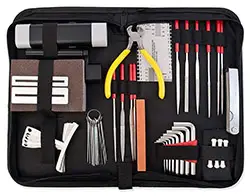
Essential for both Acoustic and Electric Guitar.
This extensive starter kit is ideal for the guitarist just getting started with guitar maintenance.
There will be a couple more items that you will need on top of this.
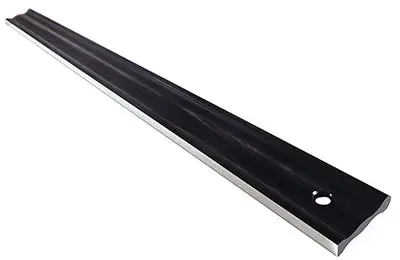
Essential for both Acoustic and Electric Guitar.
The best way to judge relief on the neck of the guitar is with a straight edge.
Having one will also make it
easier for you to determine if you have a back bow.
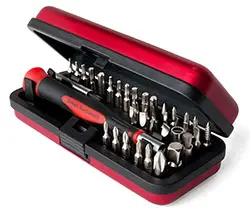
This is mainly for an electric guitar and is an excellent kit from StewMac. Most guitars have a multitude of fixings in different sizes and this set is ideal.
If you have an acoustic then you will likely have a screwdriver at home that will do all you need or you could purchase one from a hardware shop.
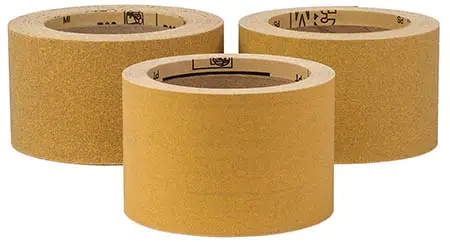
Acoustic Guitar Saddles Only.
For an acoustic guitar saddle that needs to be lowered in height, use self-adhesive sandpaper.
120 – 200 grit is recommended unless you have a lot to take off and make sure to use it attached to a hard, smooth and flat surface.
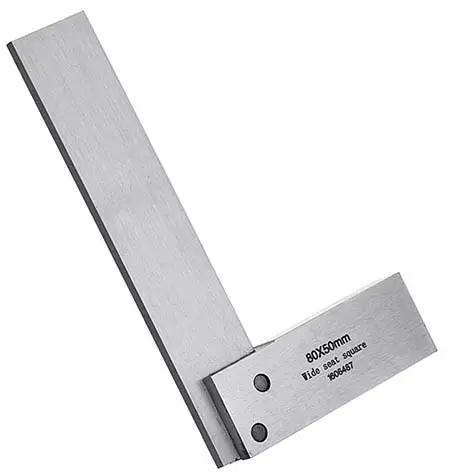
For Acoustic Guitar Saddles Only.
Make sure the saddle is square after you have sanded it down to reduce the height.
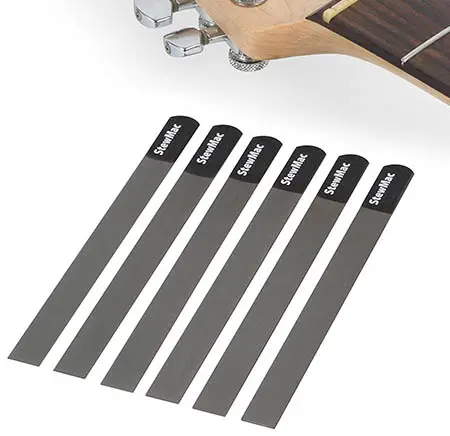
Essential for Acoustic and Electric Guitar.
Nut Files are available in different sizes dependent on the gauge of strings you like to use.
The one in this link is for medium gauge for an Electric guitar but you can get light and heavy gauge files also.
Truss Rod Wrench
Depends on the Guitar.
On top of these tools, you may need a socket wrench if the hex key wrenches in the set above do not fit your truss rod. You can find a good selection here on Amazon once you know what size you will need.
Capo
Essential for Acoustic and Electric Guitar.
Normally I would advise you on purchasing a Shure S1 Capo as per my tried and tested review which you can find here Best Guitar Capo Under $20.
However, in this circumstance, you are best off with a spring action clamp Capo as they are quicker and easier to apply and take off. One like this Kyser (click here to check price on Amazon) would be ideal
Guitar Tuner
You can download a free chromatic tuner app and this will work fine for this exercise. Like this one for iOS or this one from google play.
Non-Essential Tools – But Worth Owning
These tools will make it easier to do your guitar setup but they are not essential to perform the task. After doing a few setups though you may feel differently, I know I did
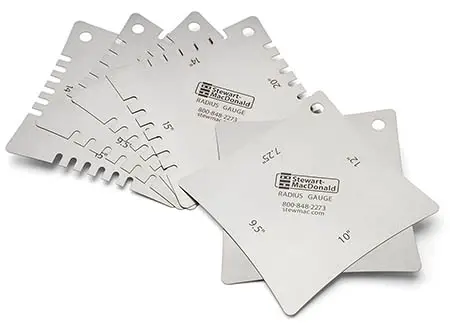
You can use the under string radius gauge instead of these but you will need to move the strings out of the way.
These Notched Radius Gauge’s save the hassle.
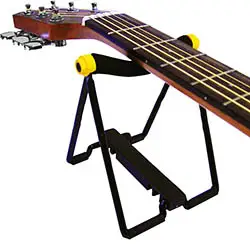
Keeping the neck supported can be a pain and an unnecessary distraction when making adjustments to a guitar and when changing strings.
A guitar neck support is ideal for solving this problem.
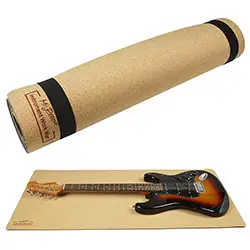
A guitar mat helps keep your guitar still and safe from scratches.
If you care about your guitar these are worth purchasing.
How To Do Your Own Guitar Setup
This step by step guide will cover the basics of setting up your guitar. It will assume that the essential geometry is correct and that there are no major fret issues or structural problems. If you have a new guitar or one that is otherwise in good shape, this guide will be perfect for you.
Fundamentally these methods apply to both acoustics and electrics, but I will point out differences in approach as they arise.
Start With The Neck Of The Guitar: Adjusting The Neck of A Guitar
As previously stated, a good set-up is a balance of the neck, the nut, and the saddle.
The saddle is separate from the bridge. On acoustic guitars, it’s the material in the slot of the bridge, and on electrics, it is the individual adjustment pieces the strings ride over.
The nut is the piece at the end of your neck that spaces the strings coming from the headstock.
Always start with the neck, or more specifically, the truss rod. A truss rod is a mechanism that counters the pull of the strings. When a guitar is tuned to pitch it exerts pulling force at the headstock and bridge, and downward force at the nut and saddle. This will cause your neck to bow.
There are some things you need to understand in order to adjust your truss rod successfully. With a grasp of how your specific rod works, the proper adjustment tool, and some practical caution, adjusting a neck is a simple operation.
Know What Type of Rod and Adjustment Nut You Have
There are two types of truss rods: single action that counters the pull of the strings, and double-action that will counter the strings and also push the neck in the direction of the string tension.
Double action rods are useful for stubborn necks that don’t have typical reactions to the pull of the strings. A neck with a back bow (a bow in the opposite direction to the pull of the strings) will result in an unplayable guitar.
Without a dual-action truss rod, the only fix for this is a more serious repair that can include major fretwork and sometimes heats straightening. Over adjustment of either rod will result in a back bow, and loosening the rod should take care of that in a properly functioning guitar.
How To Identify What Type of Rod and Adjustment Nut You Have
It may not be easy to tell if you lack experience, but the majority of rods are single action. If you have an American made Gibson, Martin, or Fender, or most any vintage guitar, you almost certainly have a single action rod.

If you are still unsure, then this video will help you identify what type of truss rod you have.
You can check with the manufacturer for the details of your specific guitar, but if your adjustment nut is not removable, you have a two-way rod. If you loosen the nut and you are able to see that you are exposing thread on the rod you are working with a single action.
What Tools Do You Need For A Truss Rod?
You will need to know what the proper adjustment tool is and never force a rod that doesn’t want to move as this could cause serious issues and a costly repair.
Sometimes you can clearly see what the nut looks like and what tool you will need, but some are not so easy.
Checking with the manufacturer or searching the internet should tell you if you are unsure. The most important thing to consider is that the wrench fits the adjustment nut with no slop.
Even if you have the correct tool, the nut may be worn or stripped and you could cause further damage trying to adjust it. Truss rod repairs can be an expensive endeavor, so make sure you have the proper tool and don’t force anything. If the nut turns but seems sticky, it may need to be cleaned and oiled.
How To Adjust The Neck of A Guitar
When you tighten your truss rod nut clockwise it will straighten your neck (or force it into a back bow,) and when you loosen it counterclockwise the neck will relieve with the pull of the strings into a forward bow.
Most necks do not end up completely straight, and the amount of bow you decide to leave in your neck is referred to as relief. You will find many opinions about the amount of relief you may or may not need in a neck, but ultimately it is a matter of preference, technique, and the individual personality of the guitar.
I believe the best playing and sounding guitars have the straightest necks. I won’t go into great detail explaining my theory behind this, but decades of setting up countless guitars of every type have led me to this conclusion.
However, there are valid reasons for wanting some curve to your neck. The physics of a moving string dictate that it moves most at the center of it’s opposing points. Some relief will provide a little extra clearance above the fret in this area.
To achieve the optimal set-up, I believe it is always best to start with a neck that is as straight as possible and add relief as needed. A neck with too much relief can suck the tone out of a guitar, and when the neck is straight the action stays more uniform as you move up the frets.
Step 1: Tune The Guitar To Pitch
Tune the guitar to pitch. There is no reason to detune if the neck is good and you have a properly functioning truss rod. Another important thing to keep in mind is to always check the straightness of your neck in the playing position.
Gravity has a significant influence on the neck, and the amount of relief will look drastically different when the guitar is laying on it’s back as opposed to sitting upright.
TIP: It’s ok to adjust the rod while it’s laying flat if you prefer, but always check the results in the playing position.
Step 2: Check How Much Relief You Have
Now check the amount of relief you have. Place a capo at the first fret or hold the string down with your finger, and fret again around the body joint where the neck starts to thicken, this is usually around the 12th to14th fret. Then note the gap between the string and the top of the fret in the middle of these two points.
Moving the string up and down over this fret will make it a little clearer, and this is easier if you are using a capo at the first fret instead of tying up both hands. You will need to check both E strings as the amount of curve can vary from one side of the neck to the other.

The best way to judge relief is with a straight edge, and a straight edge will make it easier for you to determine if you have a back bow.
For general purposes, I use an 18” edge. You can find inexpensive edges on Amazon but I find the ones available from Stewmac to be of excellent quality and worth the money. When using a straight edge I also check between the D and G strings to get an average between the two extremes.
It’s a good idea to check the neck starting at the second fret to see if it looks any different. If the first fret is high or low it can throw off the reading and this is will verify what you saw. The reading at the first fret and second should look about the same. If the gap is smaller, your first fret may be high.
If the neck is straight from the 2nd fret down and the first fret doesn’t touch the straight edge, then it is low.
Fretwork is a vast subject that I won’t get into here, so if either of these is the case and you are not comfortable with handling fret problems, have the guitar looked at.
TIP: As stated earlier, do all this checking in the playing position, and placing a light below you will help to illuminate the gap for clearer reading.

Step 3: Adjust The Neck Of The Guitar Straight
Even if the neck already has relief, it is a good idea to loosen the rod a little first to see how tight the nut is and to verify it is working properly. It shouldn’t be excessively tight and the gap should increase as you back off.
I also prefer to straighten a bowed neck rather than bow an overly straight one. It keeps positive tension at the truss rod nut, and it’s easier to read a neck while straightening.
Through many years of practice, I’ve developed the dexterity to hold the straight edge in the middle of the neck and watch the gap disappear as I tighten the rod.
It’s also just fine to do this with the guitar on it’s back, just tighten about a 1/8th to a 1/4 turn and recheck the neck in the playing position until you have eliminated the gap. It shouldn’t take more than a 1/2 turn or so in most cases.

If there is no gap and you can pivot the straight edge off of the center of the neck, you have gone too far and you’ll need to back off the truss rod.
If this happens, bow the neck and then bring it back to straight. Keep in mind you may not be able to get the neck straight, or perfectly straight, everywhere. In this case, just go with as close as you can get with no back bow anywhere.
For me, a perfect neck is dead straight on the treble side and has just a few thousandths of relief on the bass (about the amount of the thickness of a sheet of notebook paper,) but this isn’t something you can necessarily control.


Remember…we are getting the neck as straight as possible in this step, we may add some relief later on.
Step 4: Interim Adjustment To Nut – Capo Required
This will be an interim step and we will come back to actually adjusting the nut slots later. For now, we are essentially going to eliminate the nut and set it to zero. You will need a capo, and for repair purposes, I prefer the Kyser (click here to check price on Amazon).
Place the capo just behind the first fret.
Step 5: How To Adjust Saddle Height and Radius
This is where electric and acoustic set-ups differ.
With an electric, you will be able to make your adjustments simply with a wrench, but when dealing with an acoustic saddle you will need to add or remove material.
TIP: Doing this step properly requires some tools. For both you will need a ruler that measures accurately to at least 1/32”, and a set of radius gauges capable of measuring both the top of the fret and underside of the strings. These are included individually or in the StewMac setup kit, and also easily available on Amazon.
I will break this step into two sections to make it easier to follow and better illustrate what tools you will need.
Electric Guitars
There are many different types of bridges all with different saddle adjustments. You will need to determine what yours is, and if you have a Gibson style Tune-o-Matic bridge you will need a set of nut files to match each string.
A tremolo will also make this step trickier because you might need to deal with balancing the bridge by adjusting the tremolo claw that anchors the springs to the guitar.
So let’s touch on that first.
You’ll need to find the balance point for the tension of the strings so that the bridge sits level. It is important to understand that as you tune the guitar the amount of tension on the bridge changes and will cause it to move, and conversely, as you adjust the tremolo your tuning will change.
TIP: Make small adjustments incrementally, and after changing one you will need to go back and readjust the other…it’s circular and can be very frustrating if you don’t understand the relationship.
Tune the guitar to pitch. When tuning a guitar with a tremolo, I always tune back and forth to bring up the tension on the tremolo evenly: E to E, A to B, D to G.
Because the tremolo is rising as you tune-up in pitch, you will likely find you are flat when you are done. So you will have to repeat that process until you are in tune and the bridge finds its balance.
Once in tune, check to see how level the bridge is to the top of the guitar.
You will need to adjust the screws of the claw in to pull the bridge back or let them out to allow the bridge to rise. Do not move the claw the full amount all in one adjustment.
Remember that as you change the position of the claw you are also changing the tuning of the guitar and will need to re-tune, which in turn will change where your bridge sits.
TIP: You are trying to achieve equilibrium. So make small adjustments to the claw, re-tune and check again until you find the point that the trem levels when you are in tune. It can be tricky and will take some practice if you’ve never done it.

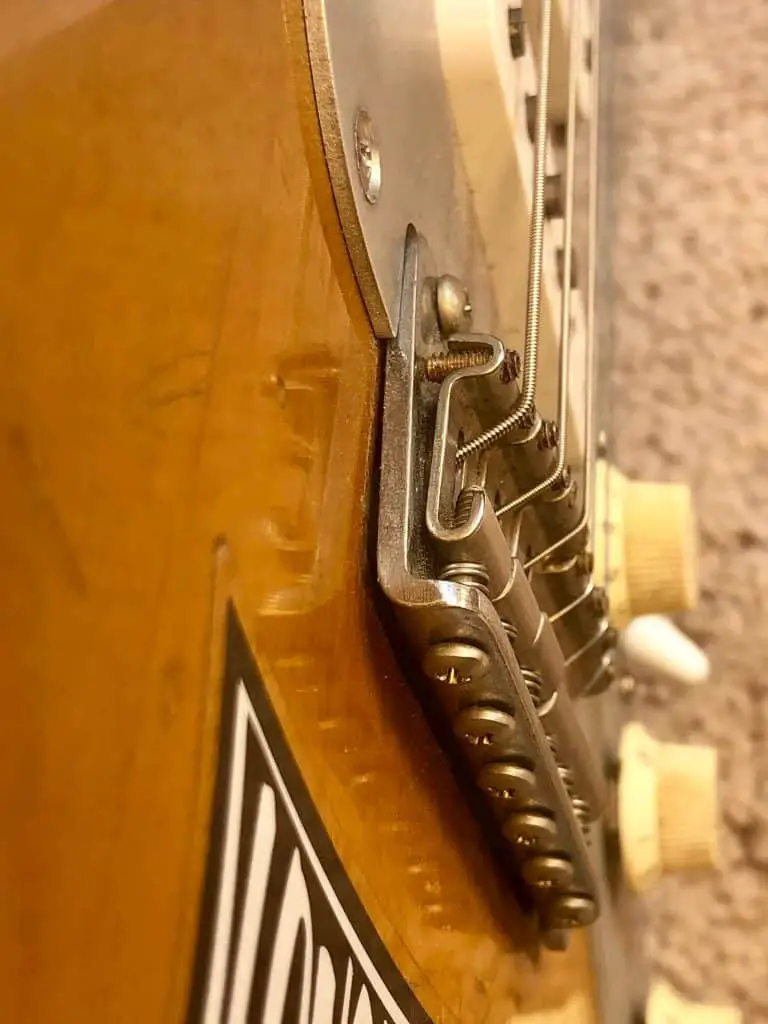


Check the radius of your fretboard. This applies to both electric and acoustic. It’s handy to have a set of notched radius gauges. If you don’t have a set you will need to loosen the strings and move them out of the way to check. You need to know what the fretboard radius is so that you can set the underside of your strings with the saddles to match.

Now set the height of the two E strings, and just like the truss rod adjustment, check these measurements in the playing position.
I start with 1/16” (1.5mm) from the top of the fret to the bottom of the treble E string at the 14th fret and 3/32” (2.5mm) on the bass. These measurements are approximate and we will likely go back and readjust them later based on how the guitar feels.
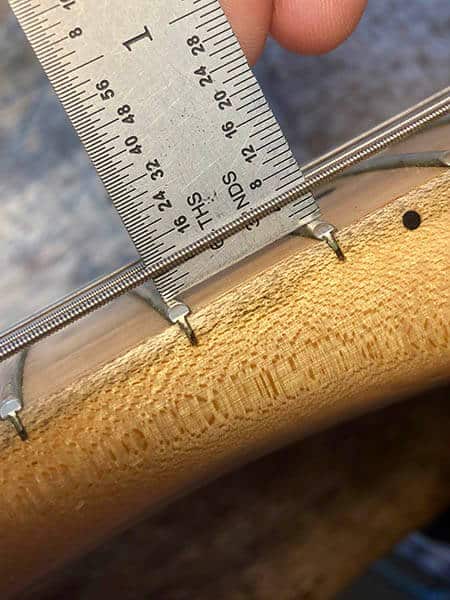

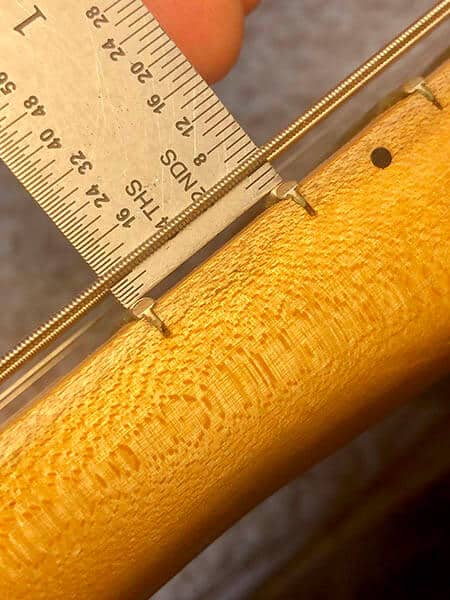

Once the E strings are set, use the under-string radius gauge to set the saddles to the fretboard measurement you took. It is easiest to raise the 4 middle strings up high until the gauge is only touching the E strings and then lower them down to the gauge.

If you have a tune-o-matic bridge you will need to use nut files for this, and if the middle strings sit below the radius you will need to use the thumbwheels to raise the E strings up higher and then lower them to the 3 and 2 measurements with the files in order to set the radius of the middle strings.

Angle the file with the approach of the string from the tailpiece, and use a file of the same gauge as each string. Remove small amounts at a time until you get where you need to be. Use some fine sandpaper to remove any sharp edges in the saddle when you are done.
Acoustic Saddles
Acoustic saddles are more involved and require greater skill.
I will focus on properly made saddles that are just a bit high or low, but first let’s talk about issues that may require the help of a repairman.
The best saddle material is bone. If yours is plastic or some type of synthetic material and you want the best tone possible, have it replaced with bone.
If your saddle is loose in the slot it should also be replaced.
When the saddle fits properly you should be able to grip it and lift the guitar up off of the bench a little, but it shouldn’t be so tight you can’t remove it easily with your fingers.
Poorly fit saddles will eventually cause cracks in your bridge.
We previously went through how to check the radius of your saddles on an electric, and it’s the same process for an acoustic.
If your saddle is significantly off and this is all new to you, then you should also make a trip to the repair shop. I could take up an entirely new article with the techniques necessary to make a good saddle, and reshaping the top of one to match a radius crosses into that territory too much for our purposes here.
Other things to look out for are cracks, major chips, and significant string wear. These can all be signs of a saddle that needs replacing.
Once you have verified your fretboard radius and checked the saddle to make sure it matches, take string height measurements with a straight neck and a capo at the first fret in the same manner as described previously.
The only difference here is that you will want to start a little higher than an electric. On the bass E, you need just under a 1/8th inch (about 3mm) and 3/32” (about 2.5mm) on the treble in the playing position. Remember, these are ballpark measurements that we can fine-tune later…it’s better to be a little high on an acoustic because it’s easy to remove more material and harder to deal with if you go too low.
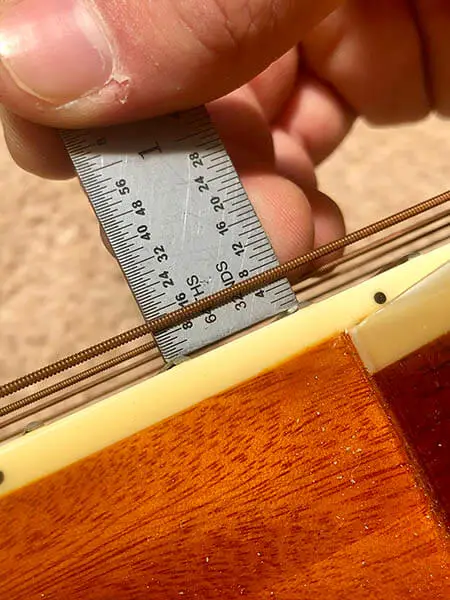
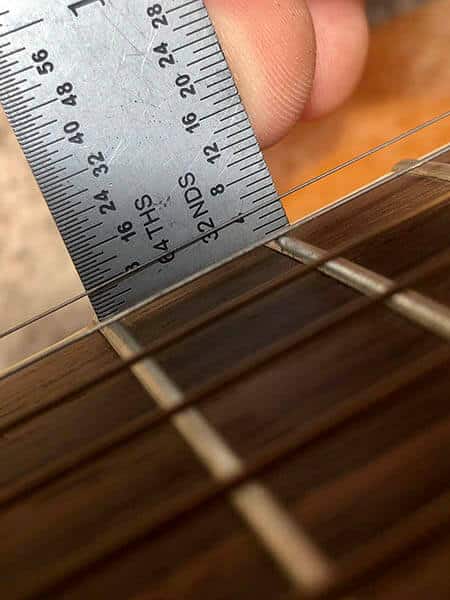


To get down to these measurements requires you to remove the saddle and take material from the bottom. You will need a hard flat surface and some self adhesive sandpaper. I like to use thick tempered glass, and I prefer the 3M brand sandpaper, but there are a variety of options here. I use 120-220 grit unless I have a lot to remove. Just make sure whatever surface you choose is hard, smooth, and flat. If you have steady hands you can even use a belt sander.
Remove the saddle and mark a line on both sides of the saddle with a sharp pencil that represents the amount of material you were above your measurements at the 14th fret. It’s not a 1 to 1 change here, so we will only remove to the bottom of our pencil line.

Using the sandpaper and the flat surface, drag the saddle towards you being careful to keep it 90 degrees to the sandpaper.

TIP: Do not sand back and forth, I find that pulling the saddle in one direction only (towards myself) is the best way to keep control and ensure the base of the saddle stays flat.
Once you get close to your pencil line, make sure the bottom of the saddle is square. Replace the saddle, tune the guitar and check your measurements again. Repeat the process if you are still too high.
If you are too low, you have two choices: replace the saddle, or shim it. In general, I prefer to replace, but sometimes a shim is warranted. I prefer to use wood as a shim and you can find thin purfling at StewMac or wood veneer available online or in hobby stores.
TIP: If you have to shim much more than about 1/32” it’s probably a better idea to replace the saddle.
The preshaped saddles from StewMac are an option if the saddle should be replaced and you’d like to try it on your own. You’ll still need to do a fair amount of work to fit it properly, but much of the shaping work has already been done for you. You’ll need to cut it to length and thickness it and set the height in the same manner as we have discussed here.
Step 7: Setting The Nut Height
When you are satisfied with your saddle height, remove the capo and spend some time playing the guitar. See how the action feels and check for string buzz.
Bend notes in the upper frets if you’re setting up an electric to be sure nothing dies out at the top of the bend. If you are getting too much noise, raise the two E strings by 1/64” (about .5 mm) at a time and reset the saddle radius on an electric.
Repeat this until you find the height that works for you. If you are setting up an acoustic, this will require shimming.
If it plays cleanly but still feels a little stiff, it may be best to leave it where it is for now and set the nut. String height coming off of the nut makes a big impact on playability and you may find it all feels right once that is done. If not you can always go back and lower the saddle some more later.
If the guitar seems to play well at the higher register, but you are getting buzzing in 3rd-7th fret range, you may need a little more relief in your neck and you can loosen the truss rod a little.
TIP: Don’t go too far. Small adjustments to the rod can make big changes. And changing the curve of your neck affects the height of your strings (both at the nut and saddles,) so if you readjust the neck, you may need to reset your saddles. Remember, all three aspects of the set-up (neck, nut, and saddle) are related, and when you make changes to one you often need to make changes to all three.
Take a look at the height of your strings over the first fret.
In theory, the nut is just a zero fret that is always fretted…so given that, the height of the strings over the first fret should be pretty close to the height of the strings over the second fret when you have a capo at the first.
Use this as a rule of thumb, but I can tell you from experience that what you are looking for is slightly higher than what you see over the second fret. Open strings move a lot, and most players tend to hit open chords a little harder, so give yourself some cushion here.


Lower the slot in small amounts with the corresponding gauge nut file at the angle of the approach of the string.
Make sure the slot is clean, put the string back, retune, and check to make sure it doesn’t buzz and see how it feels when fretted. If it’s not buzzing and still feels stiff, and looks high, remove a little more material.
This is a tricky process and there is a very fine line between low enough and too low. Keep in mind, you can make any string buzz anywhere on the neck if you want to. Don’t test the string, play it. You are verifying that it doesn’t buzz under normal playing conditions.
If your nut slots are already too low and buzzy off of the first fret or you go too far, you have the same options as the saddle: replace or shim and recut it.
TIP: I do not advise filling the slot with anything. It will just cause you tuning issues and whatever you put in there will be temporary at best.
A proper nut is critical to the tone, feel, and tuning stability of your guitar, and there really is no substitute for a well-made bone nut. However, making a perfect bone nut is very challenging and best left to a competent luthier, or perhaps the subject of a future article.
For the purposes of this set-up guide, I am assuming your nut is functional but too high. This is often the case even on brand new guitars. Adding more relief to your neck will also raise the strings up off of the first fret, but I don’t typically advise sacrificing a straight neck to avoid replacing or shimming a nut.
Once you’ve set the neck, nut, and saddle, spend some time playing the guitar.
If you are experiencing fret noise then make a note of where it is.
Higher up on the neck or dying string bends can indicate saddle action that is too low, at the end and middle of the neck can mean not enough relief, and open notes are almost always low nut slots or a back bowed neck.
Experiment with minor changes to each of these areas to see what combination works best for you and the guitar.
Just remember, a change to one of these three key factors usually means a change to one or both of the other two, so always recheck and adjust as needed.
Step 8: Intonation
If you are setting up an electric guitar, all that’s left is to set the intonation.
Setting intonation involves adjusting the saddles so that the fretted 12th note matches the open note.
If the fretted note is sharp when compared to the open note, you will move the saddle back a small amount, retune and check again until you are in tune on both. If it is flat, you will move it forward.
This is the commonly accepted approach. However, I often do it differently.
I will briefly explain and let you decide which approach you prefer for your own style.
The guitar is an imperfect instrument, there are usually only two exact notes on each string: the open note and the fretted note you choose to intonate (the 12th or halfway point of the scale in most all cases.)
Every other note on the fretboard will be a little sharp or flat. There is no law that says your twelfth fret has to be in tune, you can choose anywhere you’d like.
There are two things that occur to me when setting intonation. First, the human ear tends to forgive a flat note more than a sharp one. Neither are great, but sharp notes are more offensive to most people.
Second, when a guitar is in tune and intoned at the 12th fret, it tends to play a little sharp by the nut in the open chord range where many players spend most of their time.
So, I will usually intonate a little flat at the 12th fret in order to bring the first position more in tune. I find this reduces the overall amount of sharp notes going up the fretboard in general. I check the 12th fret and the 3rd fret and find a compromise between the two, often going until the 3rd fret is no longer sharp at all.
If for some reason you play a lot of chords up the neck, this may not work for you, but in my experience, most players fret chords toward the nut and play single notes as they get to the end of the neck, and nothing sours a chord more than sharp notes. You can experiment and see what you prefer for your playing style.
Final Piece Of Advice
Setting up a guitar perfectly can be challenging. There are many things you have to consider and it often requires trial and error until you find out what works best for the guitar and the player.
The only way to get good at it is to set up a lot of them, and the best place to begin is with your own guitar. Just remember…You have to find the balance between your neck, the nut, and the saddle.

